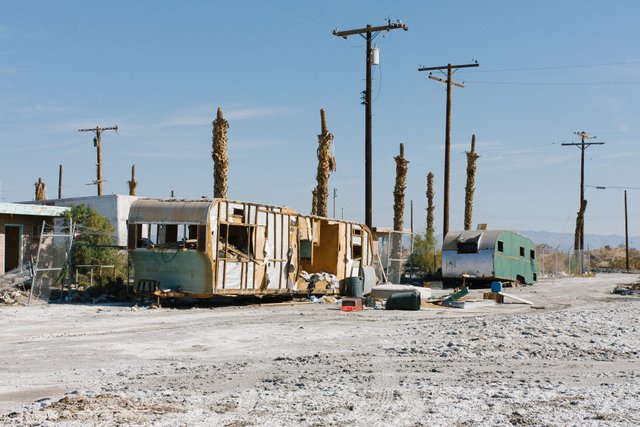10 Items To Include In Your Self-Sufficiency Plan: Power Grid Failure
Obviously the most pressing issue related to a power grid failure is the loss of power. This means everything from sanitation, refrigeration, food prep and cooking, lighting, communications, and transportation could be affected. Usually, a power outage only lasts a few hours, maybe a full day, and "most" of us will have the necessary supplies on hand to handle this kind of emergency. But, what it the outage lasted longer?

Within just a few days, a loss of power will start having a significant impact on our day to day life, especially if the outage affects a large area. If the power outage was caused by a significant storm, like a hurricane, think about how it might affect our fuel supply as well. If the fuel supply was disrupted, our ability to buy the fundamental supplies we need every day would be difficult. The trucks transporting these resources might not have the fuel needed to make the trip, this disruption would then lead to shortages of food, medication, water, etc. Think about that. If the trucks carrying our everyday supplies suddenly stopped coming, what would happen? How long would the supplies we have on hand or the supplies our local supermarkets have on their shelves last? By the end of a week, anyone not already prepared would start to panic. They would rush to their local supermarket only to be greeted with empty shelves. We have all seen what happens the night before a big storm. You head to the store and it is packed with people who are not prepared. Now, imagine if those empty shelves could not be restocked because fuel was simply not available. The state of panic would increase more and more every day as our every day are more affected.
If the power outage continued for more than a week, civil unrest would begin to grow as food, water, and basic necessities became scarce. At this point, even those who felt prepared might be running low on supplies. People would no longer be able to run generators or have fuel in their cars, and many would begin to experience disruptions in their income which would bring on additional stress as they couldn't afford any supplies they might come across. This would also be the time most would realize that emergency services, medical facilities, and emergency responders would not be able to help because they would be stretched below their capabilities.
But, what if the power outage turned into a longer-term event, what then?

How Should You and Your Family Prepare?
Here are 10 categories to consider when creating your self-sufficiency plan:
Drinking Water
You will definitely need potable water. Remember, the rule is you should have at least 1 gallon of water per day for each member of your household, 2 would be better. You should have at least a two-week supply of water on hand at all times, but longer is better. A 2-week supply should cover most scenarios but if 2 weeks goes by and power is not restored, you are back to being a victim. If you have pets, consider their needs as well; for each pet, you need at least 1 ounce of water for each pound your pet weighs, per day. That is for each pet. You should have at least a 2 week supply on hand at all times as well.
A simple addition to your household survival gear that can go a long way when it comes to having consistent, reliable water is to include a way to filter water using something like a LifeStraw Personal Water Filter or even having water purification packets. These or other filtration/ purification systems will allow you to draw water from unclean sources and extend your water supply.
Tip: Immediately after the power goes out, fill all bathtubs with water to use for flushing toilets, washing, or even drinking if needed. You can also fill buckets other containers if you have them on hand.
Food
Food is another must-have. When stockpiling food for your family, you need to plan for three meals a day, plus some snack foods for each member of your household for at least 2 weeks. Again, longer is better, and don’t forget about your pets. They too will need a two-week supply of food at least.
Choose food items that require little preparation and if possible little to no heating to prepare. Consider that cooking requires more fuel than heating; therefore, canned foods that only need heat are better than foods that require boiling because boiling takes more resources. Also, make sure you think about the size of the containers you need to have on hand. If you and your family can't finish the entire container during one sitting, what happens to the leftovers? In most cases, it would go to waste without refrigeration.
Since gas supply lines might also be affected by an outage, be sure to have an alternative way to cook or boil water. This might be a propane camp stove, fire pit, or charcoal grill, but remember, you will need the appropriate fuel on hand otherwise they are useless.
Tip: A convenient option for long-term food storage is to have MREs (Meals Ready-to-Eat) on hand.
Lighting

Since you would not have electricity, you will not have electrical lights. So, you need to have alternative ways to create light that does not involve electricity. This can be flashlights, candles, or headlamps. You will also need a means to power these lights such as batteries, matches, or lighters.
You should have at least one lantern that is bright enough to light an entire room. Whether you choose one powered by batteries, propane, or a hand crank depends on your preference.
Tip: To conserve or extend power, you might consider a solar charger. This will allow you to charge battery chargers along with multiple batteries of different sizes at the same time. You can also use light sources like glow sticks to light hallways or other frequently traveled areas without the need of battery power.
Heating
In some areas, staying warm could become an issue during a power outage. In those situations, conserving and maintaining heat will be key. To stay warm, everyone should stay in the same room as much as possible. You can even place towels under each door to seal them off so you don't lose heat. You can do the same for each window to control draft as much as possible. If you light candles, have everyone in 1 room, and control any draft, you can maintain a comfortable temperature for about 48 hours. After that, you will need to find other sources of heat until your power is restored.
As you start gathering in a room, make sure and pull out any blankets and low-temperature rated sleeping bags as well. You will also want to ensure each member of your household has enough clothing to cover them from head to toe, and enough layers so that they can add or remove clothing to regulate their temperature.
Excellent options include a fireplace or wood stove, but make sure you have plenty of fuel on hand to keep your fireplace or stove burning. Another option, although a more risky option, is a portable propane space heater. The risk is from the potential of carbon monoxide poisoning due to poor ventilation so make sure you understand the risks of using any heat source. A less risky option is to heat rocks on a fire and place them in a Dutch oven. This should get you through the night without compromising your safety.
Tip: No matter how you choose to stay warm, make sure you have a fire extinguisher on hand just in case.

Communication
Since your cell phones will probably not work for long, you need to consider other ways to communicate or at least get news. Having a hand crank radio can be invaluable in a power outage. In addition to providing important communications from the outside world, it can also be used to charge other electronic devices.
Sanitation
More times than not, sanitation is probably not something most people think about, but, proper sanitation will not only help with hygiene, it can also boost morale.
Most toilets are gravity-based so they don't rely on electricity to move the waste into the sewer system. If your toilet is gravity-based, there's no problem. If the toilet doesn't flush, you can pour a bucket of water into the bowl to flush it. Now, the water supply needed to continually use your toilet might end up being the problem if you don't have a handy source nearby. This doesn't have to be potable water but consider 4-5 people using a toilet every day for a few days or longer and you begin to get the idea of how much water you might need. This is when the water in the bathtubs will come in handy. Just make sure you know where to get non-potable water if you have to and make sure you have a backup sanitation plan in place if you can't.
If your system is not gravity based, waste will go through a pipe and gathers in a chamber where an electrical pump pushes it through a pipe to the outside sewer system or sewage tank. These are more common if you are not connected to a sewer system. If the electricity fails, waste will gather in the chamber and not move further along the path and eventually overflow. If this is the type of toilet system you have, you definitely need a backup plan.
Backup
- If manually flushing your toilet by pouring water into the tank is not an option (no water), make sure to add heavy duty contractor bags and kitty litter to your the list of supplies you need to have on hand. These can be used to craft a toilet by lining a bucket with the contractor bags and adding kitty litter. Each time the bucket is used, you would add more kitty litter.
- To make it more comfortable for kids, purchase a toilet seat and attach it to the top of the bucket. This will make them less apprehensive when using it.
- Before the bag gets full or too heavy to lift, tie it off and store it outside.
Other Sanitation Tips:
- Keep a supply of baby wipes on hand to use in place of bathing, so you don't waste water.
- In the case of a long-term outage, you will need to do laundry; consider purchasing a hand-operated mobile washer with two buckets – one for washing and one for rinsing.
- Store plenty of disposable tableware to cut down having to wash dishes, so you don't waste water.
- Stock plenty of antibacterial wipes and hand sanitizer, as these can be used without the need for water.
First Aid
Make sure you have a separate store of essential items such as bandages, antibiotic ointments, medical tools, any over-the-counter medications your family uses, and antidiarrheal medication to help your family cope with the change in sanitary and dietary conditions.
Tip: It is also important to remember that emergencies services will most likely be overloaded and response times could be slow or completely unavailable.
Protection
If the power outage continues into the long term, people will become increasingly desperate and the need to protect yourself and your family from those who were not prepared will rise. While firearms are always a popular choice, there are other options as well. Consider reinforcing the entranceways to your home and buying other forms of protection like pepper spray.
Tip: If you do decide on having a gun in the house, make sure you get the training you need and make sure you continually go to the gun range so that you understand what it means to fire a weapon.
Entertainment
If you have children, ensuring entertainment options are available is critical. This can be in the form of games, books, cards, and crafts. This will go a long way in keeping kids calm and occupied.
Backup Power Systems
Having a backup power system for your home can be an excellent way to prepare for power grid failure. This will extend your ability to be self-sufficient longer than most. A great option for a backup power source is a gas-powered generator. The DuroStar DS4000S is an excellent choice for your home. If you choose to get a generator, make sure it’s installed correctly and that you test it out to ensure you’re familiar with how it works. Also, make sure you have the appropriate amount of fuel on hand as well.
By considering each of the 10 categories above, you and your family will be better off compared to those that don't. Depending on how much you prepare and the length of time you are preparing for will determine just how prepared you really are. As I always say, I hope the supplies I buy and the time spent preparing are both a waste. These are not situations I hope to be in but I definitely want to be prepared when the time comes.

Enjoying my content? Please help support my efforts by resteeming.
Thanks So Much - Liquidtravel
Thank you for sharing your knowledge! This post has been added to our growing directory of Steemit "how to" posts for the Homesteading/Survival/Foraging/Prepper communities. Your post is helping people learn to survive and thrive now and in the future!
Thank you
This is a good prepper post and I had to double check my bug out bag to see if everything is still good. I don't have a handcranked radio though so I need to get one of those.
We had ran a simulation on how fast chaos would devolve in our city and by the third week it would be utter chaos with mass looting and crime rate at a high rise since people would be tryng to get supplies from one another.
thanks. Yeah, I don't think it would take long, especially here in the US. Most people I talk to speak agornatly about only buying food or water for a few days at a time. They seem to think it makes them trendy. Those are the people that scare me the most. I can't imagine what would happen where I live if we had a long term disruption in basic services.
thanks for stopping by..
You got a 2.20% upvote from @postpromoter courtesy of @liquidtravel!
Want to promote your posts too? Check out the Steem Bot Tracker website for more info. If you would like to support the development of @postpromoter and the bot tracker please vote for @yabapmatt for witness!
Congratulations! This post has been upvoted from the communal account, @minnowsupport, by Liquidtravel from the Minnow Support Project. It's a witness project run by aggroed, ausbitbank, teamsteem, theprophet0, someguy123, neoxian, followbtcnews, and netuoso. The goal is to help Steemit grow by supporting Minnows. Please find us at the Peace, Abundance, and Liberty Network (PALnet) Discord Channel. It's a completely public and open space to all members of the Steemit community who voluntarily choose to be there.
If you would like to delegate to the Minnow Support Project you can do so by clicking on the following links: 50SP, 100SP, 250SP, 500SP, 1000SP, 5000SP.
Be sure to leave at least 50SP undelegated on your account.
To listen to the audio version of this article click on the play image.

Brought to you by @tts. If you find it useful please consider upvote this reply.
You made good post. As a matter of facts I'm thinking now about the kind of toiletsystem we have in our house. It's an older building, so I'm not sure ... And by reading, the enormous amount of water needed get's trough my mind ... wow, better begin storing now ;-)
thank you.
CONGRATULATIONS!
Your post is featured in the Preppers' Curation Day- Weekly Edition 6 today!